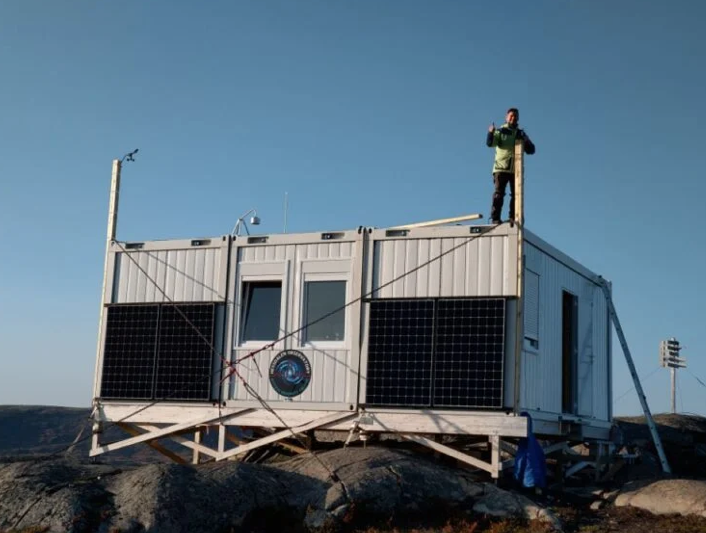Hessdalen Lights
One of the most famous photos of the Hesddalen Lights. Photo: Life in Norway
Since the 1980s Scientists have been studying a strange aerial phenomenon in Norway but they yet to find a definitive explanation.
What are the Hessdalen Lights?
The Hessdalen lights are strange, unexplained lights seen in a part of Norway called the Hessdalen valley since the 1930s. These lights can appear during the day or night and look white, yellow, or red.
They move around the valley, sometimes quickly and other times slowly. Sometimes they stay in one spot. Hundreds of people have seen these lights over the years.
At times, these lights can be as large as cars and linger in the air for as long as 2 hours. Sometimes, they may swiftly traverse down the valley before vanishing abruptly. Other times, there are instances of quick blue and white flashes that appear and disappear in an instant, along with sightings during the daytime resembling metallic objects in the sky.
In the early 1980s, there was a huge uptick in the amount of sightings. Since 1983, a group called "Project Hessdalen" and later a program named EMBLA have been trying to study these lights.
They've set up cameras and equipment to record them. Scientists from Østfold University College, Norway and Italian National Research Council are spearheading this research.
The 80s Sightings
Reports of sightings in the Hessdalen valley started in late-1981. On December 1st, there were multiple reports of unusual sightings including a "bullet-shaped object," a sphere, and various strange lights moving northward towards Trondheim. About six weeks later, on January 18th, 1982, another sighting described a strange light tilting slightly up and down as it moved.
A significant sighting occurred on February 11th when a skeptical journalist, Arne Wisth, witnessed the lights himself. Initially intending to write a dismissive piece about the sightings, Wisth changed his mind when he saw the phenomenon. He described a star-like object approaching rapidly with tremendous speed, growing larger and brighter as it came closer. The object then stopped, hovered briefly, and descended closer to the ground before disappearing. Although Wisth managed to capture a photograph, the object vanished before he could take another picture.
Wisth observed the lights again exactly one week later, on February 18th, this time with around thirty witnesses present. The lights pulsated and changed colors several times before disappearing. Approximately twenty minutes later, a long red-white luminous shape appeared, moving slower and closer to the ground between the Fjellbekkhogda and Finsahogda mountains.
Leif Havik, a well-known ufologist and writer in Norway, was among those who witnessed the initial sightings of lights over Hessdalen. During a four-day expedition starting on March 17th, he and his team encountered six separate incidents.
The first incident occurred shortly after 7:30 pm on the first evening. As they prepared to leave their transport and head to their base on Varhusvollan Mountain, Havik's colleague, Lars Lillevold, suddenly exclaimed, "There it is!" They all observed an oblong object slowly passing in front of Finnsahogda Mountain. Despite their awe, they couldn't unpack their cameras in time and proceeded to their mountain hut for the night. Shortly after their arrival at 8:39 pm, another luminous object passed over the valley, confirming the reality of the sightings.
The following evening, around the same time, the oblong-shaped object reappeared with a red light at the front and two white-yellow lights separated by a dark patch at the back. It flew low over the group for about forty-five seconds. Almost exactly twenty-four hours later, on March 19th, a "star" suddenly appeared in the night sky. Initially unsure if it was a star, the object then turned a warmer yellow-white color, growing in size as it followed the same route as the previous evenings.
Hessdalen Light Research
In 2018, the Hessdalen Observatory was set up atop a mountain, situated nearly 1,000 meters above sea level. It operates using solar panels and methanol fuel cells, allowing four researchers to work there throughout the year.
Even though scientists are studying the phenomenon, they still haven't agreed on what causes it. Some think the lights might be mistaken sightings of things like stars, airplanes, or car lights.
One idea suggests that the lights could be caused by dust particles from mining in the area burning up in the air. This theory gained attention when researchers found certain elements in the air that are known for their ability to reflect light.
Another theory proposes that the lights form when certain types of crystals in the rocks of the valley create electricity under pressure.
In 2010, a different hypothesis suggested that the lights are created by a special kind of plasma made from charged particles in the air and dust. This could be caused by natural processes like radon decay.
Piezoelectricity and the Hessdalen Lights
In a study from 2011, Gerson Paiva and Carlton Taft proposed an explanation for the strange shapes seen at the center of the Hessdalen lights. They suggested that these lights form clusters due to interactions between different types of waves in the air. These clusters of light balls can shoot out at very high speeds, similar to what's been observed. The central ball is white, while the ones that shoot out are green, likely because of certain types of ions in the air. These ions break apart more quickly than others, so only certain colors are seen.
Paiva and Taft also developed a model to explain the specific pattern of light seen in the Hessdalen lights. They suggested that the light behaves like thick gas, which affects how its spectrum looks. When the air is clear, the light shows a certain pattern. They also proposed that the shapes of the lights might be caused by rocks underground breaking apart quickly.
In 2014, Jader Monari introduced another theory, suggesting that the valley itself could act like a battery. In this model, the river and the sides of the valley play roles similar to the parts of a battery. Gas bubbles rising from the ground could become charged and create the Hessdalen lights.
Paranormal Theories about the Hessdalen Lights
The shape taken by the lights in this image could be imagined as reflective surfaces on a spacecraft.
UFO enthusiasts often find the Hessdalen lights intriguing and compelling evidence of extraterrestrial activity. Some believe that these lights could be manifestations of alien spacecraft or advanced technology from other worlds. They argue that the lights' behavior, such as their sudden appearances, rapid movements, and unconventional shapes, are consistent with characteristics commonly attributed to UFO sightings.
Paranormal theories about the Hessdalen lights propose various supernatural explanations. Some suggest that the lights are manifestations of ghosts, spirits, or otherworldly entities. Others propose connections to ley lines, Earth's energy grids, or mystical phenomena. These theories often draw upon folklore, pseudoscience, and speculative interpretations of the lights' behavior to support their claims.
What do you think is causing the Hessdalen Lights? Tell us your theories in the comments.
If you enjoyed this article you might also be interested in Kristina Florence’s UFO Abduction or the 1994 Muskegon UFO Sightings.
Are you a paranormal investigator? Try our free spirit communication app

































